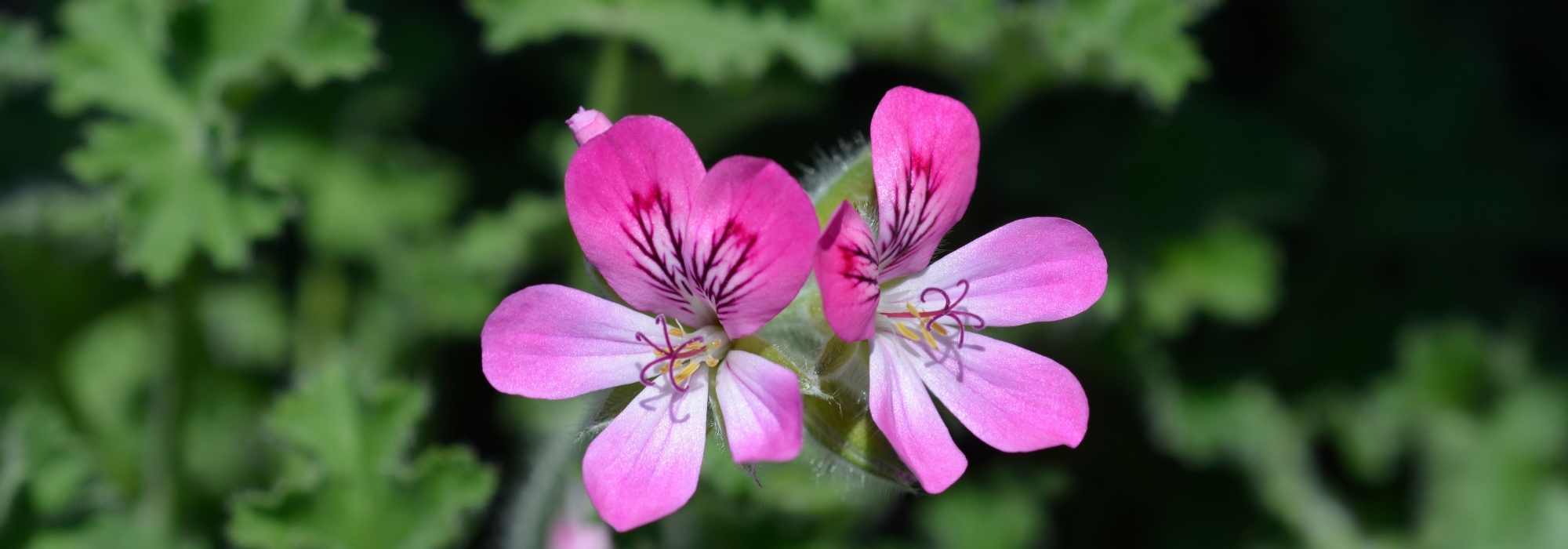
Scented Geranium: Planting, Care, and Benefits
Contents
The Scented Geranium in a Few Words
- Its leaves exude scents of rose, lemon, orange, mint, or spices
- It is the ultimate anti-mosquito plant!
- Being frost-sensitive, it is grown as an annual and should be brought indoors in winter
- Easy to grow and drought-resistant, it thrives in full sun in very well-draining soil
- It flowers all summer in gardens, balconies, terraces, conservatories, and windowsills
The word from our expert
The Scented Geraniums or Pelargoniums with fragrant foliage are beautiful, tender shrubs covered in leaves that release their scent at the slightest touch. Their foliage exudes a wide variety of fragrances, from rose and citrus to lemongrass, pineapple, frosty mint, spices, or even dried fruits, depending on the variety. The scents are so intense that they repel mosquitoes, much like the Pelargoniums from the ‘Mosquitaway‘ series. A major advantage in summer!
Their delicate summer flowering, most often in pastel shades, white or pink, is another of their qualities. They bloom from June to September, producing small flowers grouped in umbels. Another highlight: the leaves of scented pelargoniums are edible and also offer cleansing and healing benefits for the skin.
The only drawback of these woody perennials is their sensitivity to cold! Planting them directly in the ground is only possible in our mildest regions, free from frost. Being frost-sensitive, they are grown as annuals in the ground or in pots to be sheltered in winter. Plant them in the garden or in pots in a conservatory, but never too far from the house to enjoy their fragrance.
Their planting is incredibly simple, and they grow quickly with minimal maintenance in light, well-drained soil and full sun.
As beautiful to look at as they are to smell, discover our tips for growing Scented Geraniums successfully!
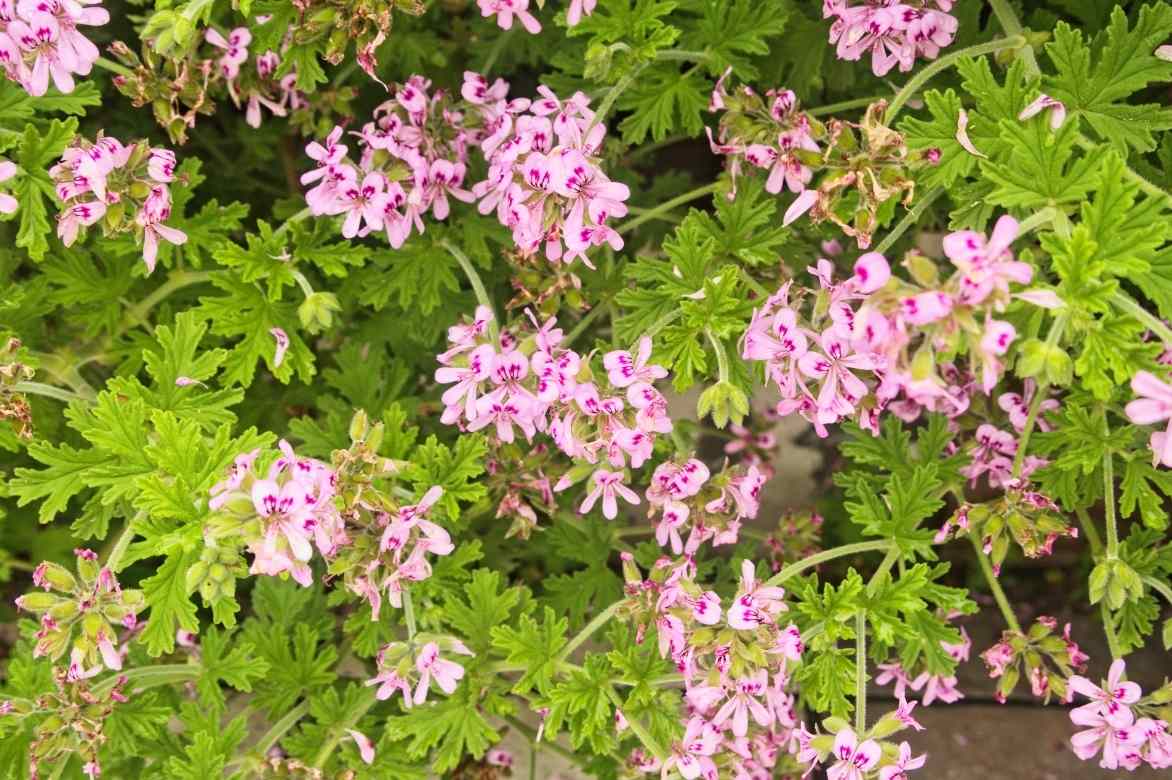
Pelargonium graveolens or Rose Geranium, one of the most well-known
Description and Botany
Botanical data
- Latin name Pelargonium
- Family Geraniaceae
- Common name scented pelargonium, scented geraniums, fragrant-leaved pelargoniums
- Flowering June to October
- Height 0.35 to 1.50 m
- Exposure Sun
- Soil type Light, dry, well-drained
- Hardiness Frost tender
The fragrant-leaved pelargonium or scented geranium is a beautiful evergreen shrub from the Geraniaceae family, native to South Africa, where it grows in mountainous areas, damp ravines on the edges of forests, on sandy, rocky, or gritty soils, as well as on schist or limestone. Thriving in hot, humid summers and mild winters, it has low hardiness. Sensitive to frost, it is cultivated in our climates, except in coastal areas, usually as an annual to be sheltered in winter if you wish to keep it from one year to the next.
The genus Pelargonium includes 300 species and nearly 1,000 varieties. Many cultivars and hybrids have been developed from about twenty species of this vast family, which includes Pelargonium grandiflorum, the florist’s geranium (Pelargonium x domesticum), the ivy-leaved geranium, nicknamed the “King of Balconies,” or the zonal pelargonium, for example.
There are around 130 species of scented pelargoniums. Among them, the Pelargonium graveolens or rose-scented geranium, the most fragrant of all, highly prized in perfumery and the origin of many hybrids, the Pelargonium fragrans, with a pine-like scent, Pelargonium tomentosum with very velvety foliage, the Pelargonium crispum with intensely crisped foliage, Pelargonium odoratissimum, the Pelargonium denticulatum Filicifolium, or the Pelargonium quercifolium, known as the “oak-leaved geranium.”
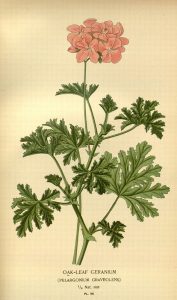
Pelargonium graveolens, botanical plate 1897
From a taproot, this perennial forms an airy, highly branched bush whose stems become lignified over time, reaching heights of 35 cm to 1.50 m in all directions, or even more in the ground in mild climates. The habit varies by species, semi-trailing, upright, or trailing. Protected from frost, it can live for several decades.
This type of geranium captivates with its remarkable foliage, lush and evergreen in regions spared by winter frosts, and highly aromatic when touched or crushed. The leaves also differ from one species to another. The lamina is divided, deeply lobed, peltate, undulate, finely chiselled, or conversely crisped, with edges that are plicate or shaped like a cornet in the case of Pelargonium cucullatum. It can be so finely divided that it resembles fern foliage or so lobed that it resembles oak leaves. It may be downy in Pelargonium tomentosum or rough to the touch, slightly sticky, or even succulent in Pelargonium gibbosum. The leaves, always veined, measure 4 to 10 cm in length and width. They come in all shades of green and are sometimes variegated with yellow, cream, or even tinged with chocolate brown.
Covered with hairs secreting a highly fragrant essential oil, the leaves release a powerful scent at the slightest touch, under strong sunlight, or after a shower. This foliage exudes a wide variety of fragrances: rose, lemon, lemongrass, orange peel (Pelargonium (x) citriodorum ‘Prince Of Orange’), mint, spices, and even carrot (‘Scarlet Unique’), pepper (‘Endsleigh’), cinnamon, maritime pine (Pelargonium (x) fragrans), green apple, hazelnut (pelargonium ‘Concolor Lace’), or even bitter almond. The pelargonium x graveolens and pelargonium rosat (P. capitatum), with their rose-like scent, are highly prized in perfumery. Varieties with a particularly lemony scent are said to be even more effective at repelling mosquitoes. Edible, the leaves can flavour fruit salads or oils. Dried, they enhance potpourris.

Pelargonium cucullatum, Pelargonium tomentosum, Pelargonium graveolens, Pelargonium crispum, and Pelargonium quercifolium (© Keith Edkins)
The fragrant-leaved pelargonium offers a profuse flowering from June to October. Submerging the foliage, the single or semi-double flowers appear in small umbels. They are quite large, sometimes measuring more than 4 cm in diameter. Each flower is composed of two upper petals and three lower petals. They bloom in pastel and delicate shades, displaying various tones of pink, lavender, and purple, often veined with contrasting spots. Some varieties stand out with a delightfully bicolour or tricolour flowering, while others display macules of a very intense hue. The Pelargonium gibbosum stands out with an astonishing yellow flowering, rarely seen in pelargoniums.
The flowers are also edible, and the English use them to flavour their jellies.
This flowering attracts many pollinating insects and turns into long-beaked fruits, “Pelargos” meaning “stork’s beak.”

Flowering of Pelargonium graveolens ‘Lady Plymouth’, ‘Concolor Lace’, and Pelargonium capitatum ‘Pink Capricorn’
What Are the Most Beautiful Scented Geraniums: Our Favourite Varieties
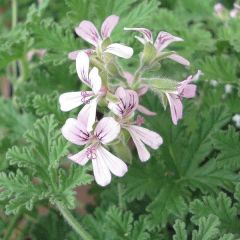
Pelargonium fragrans
- Flowering time July to October
- Height at maturity 60 cm

Pelargonium graveolens
- Flowering time July to October
- Height at maturity 60 cm
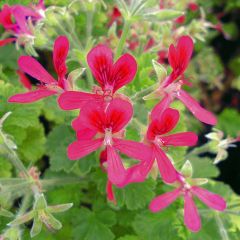
Pelargonium Concolour Lace
- Flowering time July to October
- Height at maturity 50 cm
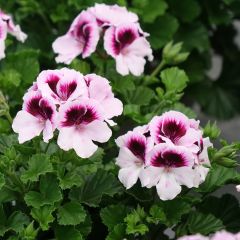
Pelargonium Mosquitaway Lizzy
- Flowering time July to October
- Height at maturity 35 cm

Pelargonium quercifolium Royal Oak
- Flowering time July to October
- Height at maturity 60 cm

Pelargonium citriodorum
- Flowering time July to October
- Height at maturity 60 cm

Pelargonium Angel's Perfume - Regal Geranium
- Flowering time July to October
- Height at maturity 35 cm
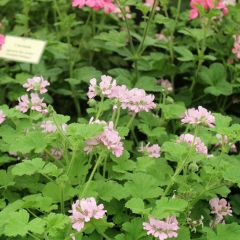
Pelargonium Attar of Roses
- Flowering time July to October
- Height at maturity 60 cm
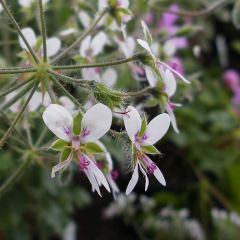
Pelargonium tomentosum
- Flowering time August to October
- Height at maturity 50 cm
Discover other Scented Geranium
View all →Available in 1 sizes
Available in 2 sizes
Available in 1 sizes
Available in 3 sizes
Available in 2 sizes
Available in 0 sizes
Available in 0 sizes
Available in 1 sizes
Available in 1 sizes
Available in 1 sizes
Planting Scented Geraniums
Where to Plant a Scented Geranium?
Pelargonium is a non-hardy perennial plant that cannot tolerate frost. This is why, in our climate, it is generally grown as an annual in the ground or planted in pots to be brought indoors during winter and taken back outside in May. It can survive in the ground in mild climates if winter temperatures do not drop below -4°C. This delicate plant, native to South Africa, loves the sun and dry soils. It requires a minimum of 4 hours of sunlight per day. In the southern regions of our country, it will tolerate partial shade. It is an undemanding plant that thrives in very well-drained soil, even if it is chalky and occasionally dry in summer.
It tolerates summer drought well and fits perfectly in dry gardens or coastal areas. It quickly adds a floral and fragrant touch throughout the growing season. Plant it in flower beds, along pathways, in pots on the terrace, under a window where it will repel mosquitoes, or even in a conservatory. Scented geraniums also make wonderful low hedges, always close to the house to enjoy their fragrance.

Pelargonium crispum
When to Plant a Pelargonium?
Plant your scented geraniums in the ground after the last frost, usually in May for most regions. For planting in containers or pots, wait until the risk of frost has passed before placing them outdoors.
How to Plant It?
Planting in the Ground
You can plant them in groups of 4 or 5. Space them 20 to 30 cm apart. Easy to grow, pelargoniums are content with soil that isn’t necessarily rich but is well-drained. In heavy or clay soil, add gravel or coarse sand to garden soil to prevent waterlogging around the roots.
- Dig a hole three times wider than the root ball
- Create a good layer of gravel for proper drainage
- Place the plant in the centre of the hole without burying the collar too deeply
- Fill with the excavated soil mixed with leaf compost
- Lightly firm the soil
- Water after planting, then moderately without soaking the roots
Planting in Pots
All scented geraniums are suitable for pot cultivation. They can be placed outdoors during the growing season and brought indoors at the first sign of frost or grown in a conservatory year-round. Space the plants about 15–20 cm apart.
- In a large container at least 50 cm in diameter, add a good layer of drainage (gravel or clay pebbles)
- Plant in a well-draining mix of half “geranium” compost and half horticultural sand
- Water
- Place in a sunny spot
Maintenance, pruning and care
The scented geranium requires very little maintenance, only fearing frost. In overly damp soil, it risks root rot. Water during the first two summers after planting, then only during prolonged dry spells and always moderately. Too much moisture could kill the plant, which does not appreciate excess water at all.
In pots, ensure less spaced-out watering and water as soon as the soil dries on the surface: once or twice a week. It’s a hungry plant: during the summer, provide regular doses of geranium fertiliser to support the flowering of your pot-grown plants.
Regularly remove faded flowers and yellowed foliage to encourage the appearance of new flowers and extend the flowering period.
When to prune scented geraniums?
Pruning helps balance or reduce the branches, rejuvenate stems, and promote growth and flowering. Scented geraniums should be pruned in September:
- During the season, you can trim overly long stems
- Before winter storage, with pruning shears, cut back the still-green stems by about one-third of their height, without touching the old wood
How to preserve a scented geranium?
Scented geraniums can only remain in the ground in mild climates, such as coastal gardens, the south of France, and all regions spared from heavy frosts. As winter approaches, bring pots indoors to a very bright, frost-free location, such as a greenhouse, winter garden, or conservatory at 12 to 15°C. You can move them back outside after the frosts. You can preserve your ground-grown scented geraniums from one year to the next by uprooting them and temporarily replanting them in containers to store in a frost-free, unheated location. Replant them in the garden in spring. Throughout winter: one watering per month should suffice. Also, stop all fertiliser applications. In spring, remove dry leaves and repot in fresh compost.
To learn all about overwintering, visit our advice page: Successful Overwintering of Pelargoniums
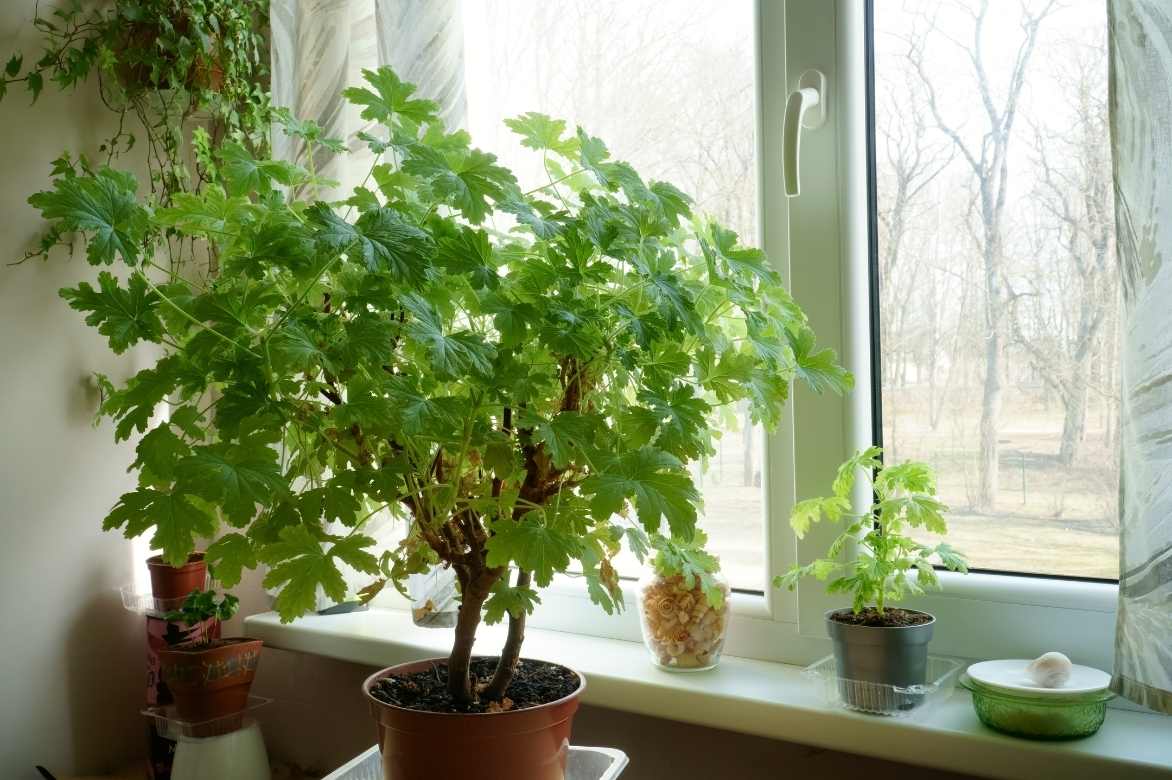
A beautiful scented geranium stored in a bright room for the winter months
Diseases and potential pests
Scented geraniums are hardy. Plants grown in greenhouses year-round may be more sensitive. Cold and excess water are responsible for grey mould on the roots and base of the stems (blackleg), which is why well-drained soil is essential. To eliminate any whiteflies, you can spray a solution based on black soap and vegetable oil.
To combat red spider mites, common indoors, spray a nettle infusion.
If necessary, keep slugs away naturally with our advice.
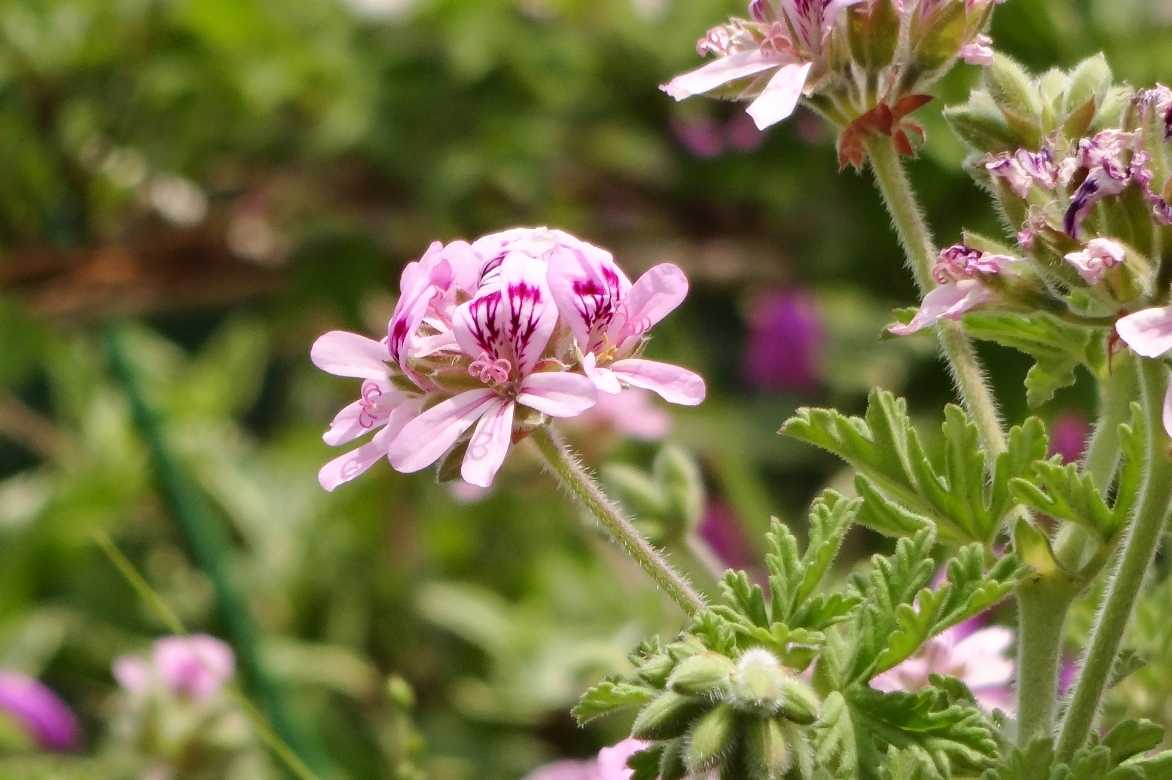
Pelargonium graveolens
Multiplication
Scented geraniums can be easily propagated by cuttings in late summer. Sowing under cover in late winter with seeds from the previous year is possible but more delicate and unpredictable. We recommend propagation by cuttings instead.
How to take cuttings of scented geraniums using the layering method?
- From August to September, use pruning shears to take 10-15 cm long lignified shoots without flowers, cutting just below a node
- Remove the leaves at the base of the stems
- Cut the base at an angle and make an incision with a sharp knife
- Insert the cuttings into a tray filled with a well-draining mix of river sand and turf or special propagation compost, burying them halfway
- Water
- Place in a warm frame (15-20°C) under a mini greenhouse or plastic cover
- Keep the substrate moist until rooting occurs
- Store in shade or indoors
- After 8 to 10 days, transplant into individual buckets
- Protect your young plants from frost all winter in a bright room
- Plant out the following spring, in May when the soil has warmed sufficiently
Associate
Scented geraniums adapt to all garden styles, from the most romantic to the most naturalistic, pairing easily with many summer flowers, whether annuals or perennials. Scented geraniums thrive in warmth and light.
In a fragrant garden, English roses like ‘Boscobel’, with its strong floral scent, will keep them company, as will peonies, lavender, butterfly bushes, and honeysuckles. With lavender and roses, they harmonise in soft, colourful arrangements.
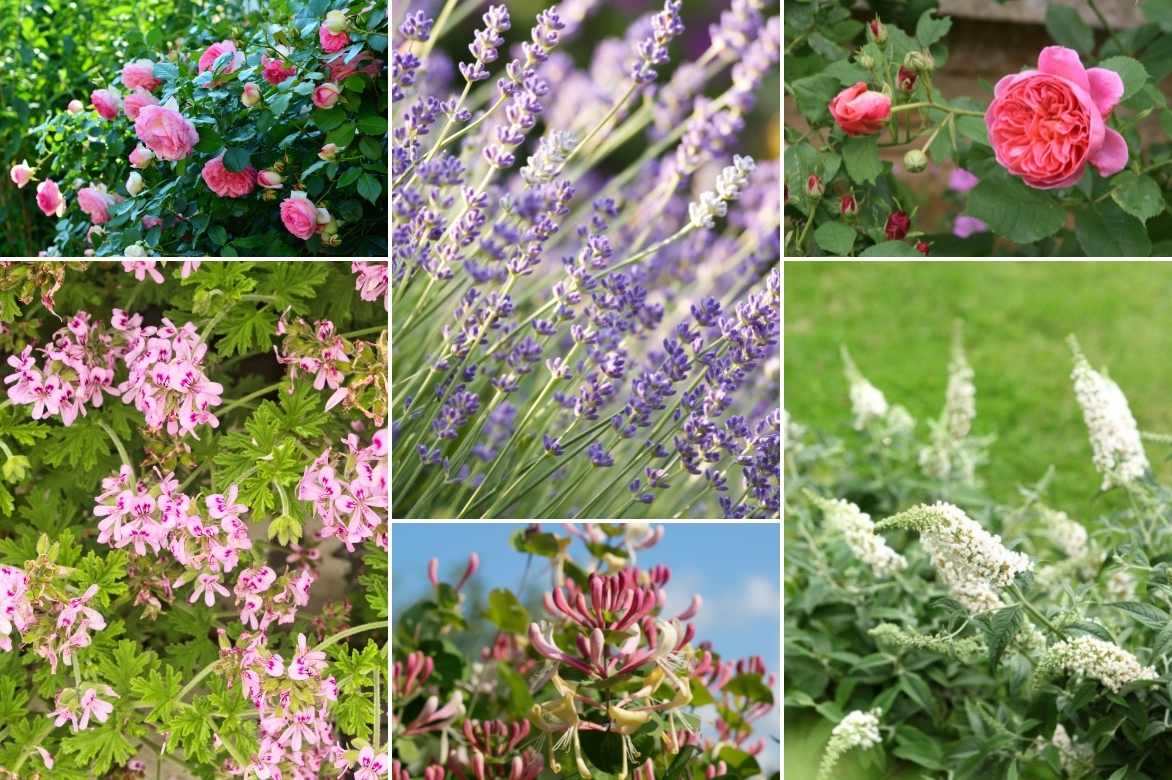
Rose-scented geranium surrounded by roses, ‘Munstead’ lavender, honeysuckle, and a Buddleia ‘Ice Chip’
Because their leaves are edible, you can also pair them with aromatic plants like rosemary, thyme, oregano, Salvia officinalis, and helichrysum. Combine them with drought-resistant perennials like lavender cotton.
In a planter or pot, you can accompany your Pelargoniums with coleus, lobelias, diascias, and petunias. In a summer border, they will pair well with Buenos Aires vervain, mealy sage, alliums, and sweet williams.
They will punctuate a summer flowering bed alongside ceanothus, dahlias, begonias, and rudbeckias. Their delicate flowering also pairs beautifully with airy plants like nepeta, tobacco plants, or cosmos. To complement their mauve or pink flowers, you can place them near plants with grey foliage, such as artemisias.
Useful resources
- Discover our scented geraniums: their foliage releases a variety of fragrances capable of warding off a squadron of mosquitoes!
- Advice sheet: 5 repellent plants to keep wasps away
- Advice sheet: 10 fragrant pelargoniums
- Subscribe!
- Contents
































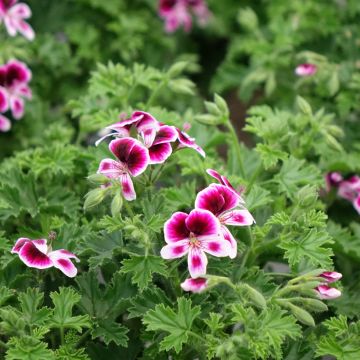
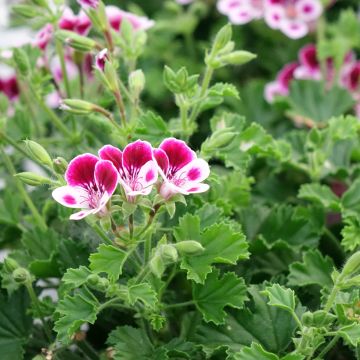
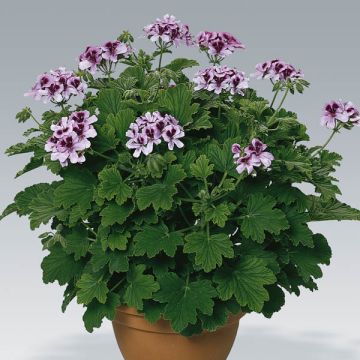
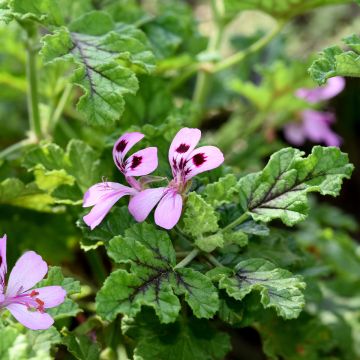

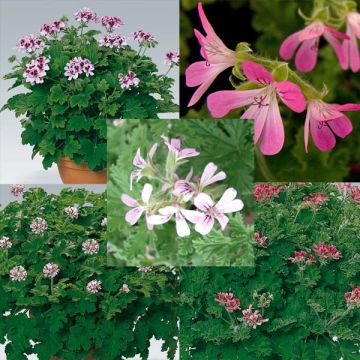
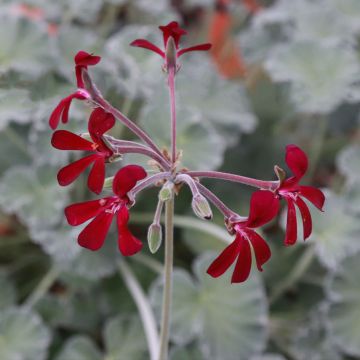
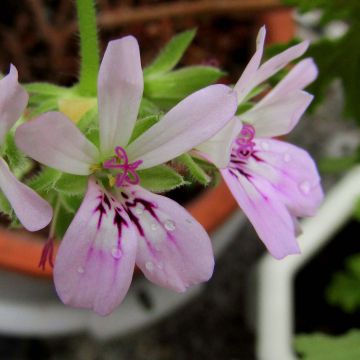

Comments